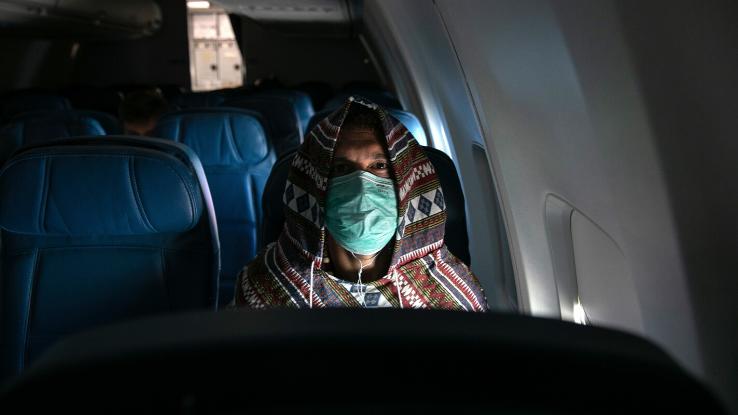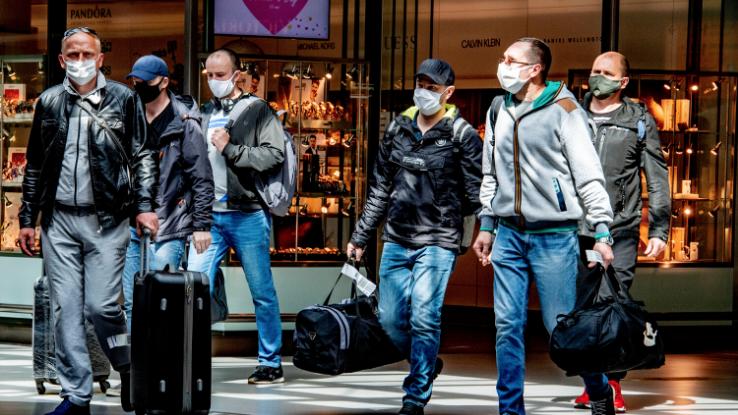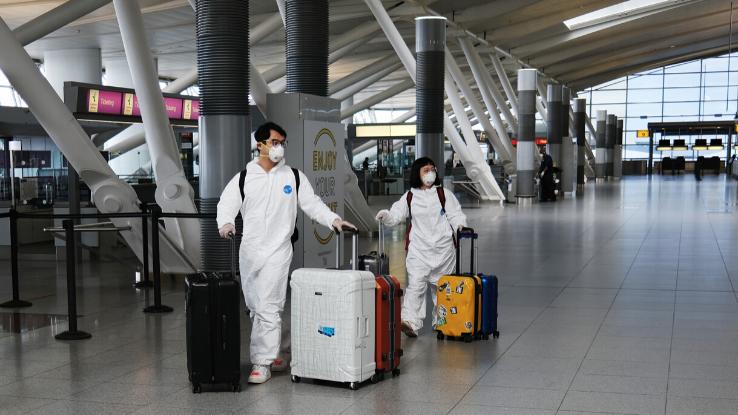How To Change The Battery On Macbook Air

The far-reaching effects of the novel coronavirus pandemic took a toll on nearly every industry imaginable, simply the travel industry was hit particularly difficult. With travel bans and shelter-in-identify directives limiting folks' ability to fly, airlines began canceling a record number of flights as the number of people traveling by air dropped sharply. According to The New York Times, the number of commercial flights had, in August of 2020, dropped by 43% of what they'd been pre-pandemic, but to some experts this was cause for celebration. They considered this the "best figure" since March of 2020 — and since the 77% driblet in flights that occurred in April of that year.
Needless to say, the in one case-booming aviation industry was hit hard by the pandemic. And then hard, in fact, the industry received $54 billion in bailout money from Congress — and information technology took more than a yr from the kickoff of the pandemic for even one airline to brainstorm posting profits again.
Since restrictions began lifting and the COVID-xix vaccines became bachelor to well-nigh of the U.Due south. population, it became evident that people were itching to fly the friendly skies again, with NPR reporting that, in just over a year since the pandemic began, air travel had risen back up to pre-pandemic levels. What's also become clear is that nosotros shouldn't wait things to just "become back to normal," no affair how much we might want them to. The COVID-19 pandemic showed us that there's no going back, period — there's just going to be a new normal to accommodate to, and for airports, airlines and passengers, this new normal probable ways new rules.
COVID-19 Began Changing Air Travel Almost Immediately
For those who nevertheless needed to travel when the pandemic commencement striking, airlines enacted fairly drastic changes, all in the proper name of condom and, of course, to mitigate the spread of the novel coronavirus. For example, JetBlue, known for having a grab-and-get snack cupboard on nearly of its flights, suspended drink and snack service, while airlines similar Delta blocked off middle seats, started boarding the planes back to forepart and but allowed 10 passengers to board at a given fourth dimension to maintain social distancing. Speaking of social distancing, almost large-name airlines capped their occupancies at around 50% — not that flights were selling out anyway — to make more than room for passengers to spread out and maintain safe distances from 1 another.

Nevertheless, it'south hard to predict how cross-country and interstate travel will continue to exist impacted. Past May of 2021, all major airlines had officially ended their social distancing requirements and stopped blocking off middle seats. Mask mandates weren't lifted, however, which begs the question, "How strict volition airlines become when it comes to practicing social distancing in the almost future?" In the aftermath of September xi, air travel changed drastically in the United States. From bulletproof cockpit doors and stricter ID guidelines to the creation of the Transportation Security Administration (TSA), the aviation industry and other powers that exist reshaped not just how we travel but too our perception of travel. The COVID-nineteen pandemic stands to do the aforementioned, maybe to a lesser degree.
Scott Duncan, a partner at Skidmore, Owings & Merrill, was interviewed by Vogue and asked how things, especially airports, might change from a design perspective. Ane of Duncan's projects, a loftier-rise in Wuhan, Cathay, brought to light the fact that elements like ventilation, sunlight and light-green spaces take all become higher-priority features. "Outdoor spaces are going from 'Oh, this is nice to have' to 'It's a 18-carat assiduities and possibly a necessity to travel,'" Duncan told Vogue.
While redesigning or revamping airports in a thoughtful way is probable on the horizon, at that place are other safety considerations that the pandemic acquired facilities and companies to implement more than quickly. For example, United began testing touchless kiosks then customers could print tags and check bags without being exposed to germs unnecessarily; Southwest installed plastic shields at ticket counters and gates to protect their workers; and some airlines, similar Frontier, started taking passengers' temperatures. Ahead of the eventual travel uptick, the U.S. travel manufacture released guidance for "Travel in the New Normal" and then airlines could stay on the same folio beyond the board when it came to emerging sanitation and other protective measures.
What Further Changes Can We Wait When It Comes to Traveling in the "New Normal"?
In addition to taking temperatures and installing plastic shields, airlines tin be expected to do everything in their ability to uphold social distancing standards. Regardless of how various states reacted — some began loosening or eliminating guidelines and lockdowns very early on on, while others kept things adequately rigid until larger segments of their populations had been vaccinated — there remains a need for airlines need to err on the side of caution. Even equally need for flights has begun to increase, airlines still need to earn consumers' trust, and that means practicing an abundance of caution.

Another style to win over audiences? Flexible cancellation and rebooking policies. Having the power to change travel plans was key during the pandemic, and it remain this way in our post-COVID-19 globe. Most airlines allowed passengers to rebook flights and travel plans that were impacted past the pandemic, no questions asked, and even extended miles benefits into the next calendar year. Here's hoping that mentality sticks around.
In addition to lower cabin capacities, we're hoping airlines might rethink their conclusion to reopen middle seats to continue to let for mile-high social distancing. Aviointeriors, an Italian company, has an interesting solution in the "Janus" seat — a backwards middle seat that's surrounded on three sides by shields to allow for "maximum isolation betwixt passengers," or so its press release states. Adopting new cabin interior blueprint features would, of course, accept time. For at present, leaving middle seats empty (as much as possible) and requiring face up coverings is an easier solution, and almost airlines are notwithstanding requiring passengers to mask up if they desire to board their flights.
Some other things we'd beloved to see? A more than widespread employ of temperature checks, pre-packaged meals, fewer (if any) touchscreen kiosks and boarding policies that limit how many passengers tin can besiege near the gate. Fifty-fifty before the COVID-19 pandemic, flight had its stress factors, just here's hoping that the aviation industry pulls together to put passengers' and workers' safety kickoff far into the future.
How To Change The Battery On Macbook Air,
Source: https://www.ask.com/travel/life-after-covid19-air-travel-changes?utm_content=params%3Ao%3D740004%26ad%3DdirN%26qo%3DserpIndex
Posted by: proctorthicy1960.blogspot.com


0 Response to "How To Change The Battery On Macbook Air"
Post a Comment